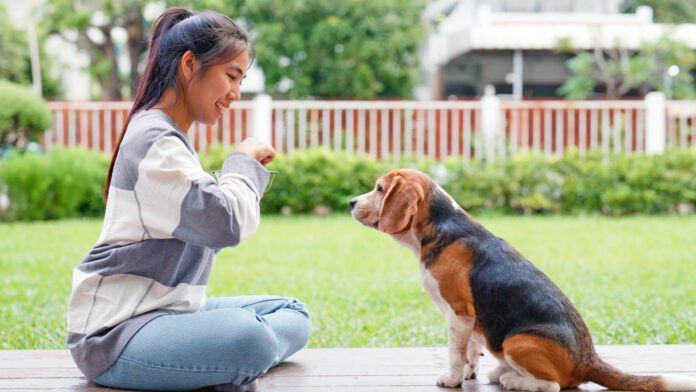Michigan State University (MSU) trains its athletes using five golden rules as a guideline to ensure positive reinforcement works. Not only do we think these five golden rules are excellent for human athletes, but we found that the coaching advice can apply to dog training as well. MSU’s five golden rules of positive reinforcement are:
- Planning
- Contingency
- Parsimony
- Necessity
- Distribution
Now let’s look at how that we adopted MSU’s coaching advice to apply to positive reinforcement dog training.
Dog Training Golden Rule No. 1: Planning
Clearly identify the behaviors that you want to increase and reinforce. This is dog behavior modification 101. Knowing what behaviors that you want to work toward will help you move forward better. You should also know what each step will look like. With many behaviors that you want to train, you may need to break it into smaller steps, depending on the dog in question. Expecting to modify a behavior all in one fell sweep can create frustration on both sides of the equation.
Dog Training Golden Rule No. 2: Contingency
This involves reinforcement, which starts with marking the behavior that you want or the individual step forward toward the behavior modification. Be mindful that the dog in question is first understanding the role of the marker (whether that be a clicker or a verbal marker) and second having the marked behavior immediately reinforced. Most of the time, this will involve a tasty treat, but there are other reinforcers that can be used. That will depend on the dog, the environment, and the practicality of what is most reinforcing to that dog at that moment.
Dog Training Golden Rule No. 3: Parsimony
This one is a little confusing. One of the published meanings of “parsimony” is the scientific principle that things are connected in the simplest manner. When implementing dog behavior-modification techniques, this means the marker, whether it be the clicker or the verbal marker, that you use when the dog performs the behavior that you are looking for or the next step in the behavior that you want to move toward. Personally, I use the marker word “yes!” but you can use any word that you do not use regularly in conversation, or you can use a clicker. The timing is what matters as well as the dog’s understanding that hearing that word means that the action performed at that moment is desirable and will be reinforced.
Dog Training Golden Rule No. 4: Necessity
This one may sound easy, but it’s not. It relates to reinforcement directly from the behavior. For example, if a dog is worried about new humans but is also interested in learning about such, reinforcement coming directly from the behavior that you want more of can come in the form of being able to approach the new person to sniff for information gathering purposes, while being ignored by that person. Then being permitted to walk away to process that information. Those actions are self-reinforcing and allow the dog to learn to feel safer.
Dog Training Golden Rule No. 5: Distribution
This one is easy. Distribute reinforcement properly. Don’t be stingy, especially in the earlier stages of learning. You can be random later, when you are sure that solid learning has taken place. Reinforcement must be worth the dog’s efforts to effectively move forward. This is one of the subjects that I spend so much time stressing to clients. If your reinforcers are not getting your dog’s attention sufficiently, they will not success in the manner that you hope for. Be generous, please!
To sum up, take stock of your training plan regularly to make sure that you are effectively hitting each point properly. Set your dog up for success! Never use aversive or “balanced” training methods. You won’t regret the time spent doing things correctly.







I like to share WDJ articles to help new dog owners. However this article could be edited to be easier to understand. Perhaps a definition of terms early on the article so that description of actions is more concise.
I had trouble following the article dispute being a dog trainer who loves to expand her vocabulary.